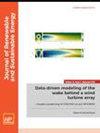Modeling and comparative assessment of solar thermal systems for space and water heating: Liquid water versus air-based systems
IF 1.9
4区 工程技术
Q4 ENERGY & FUELS
引用次数: 0
Abstract
This work pertains to the transient modeling and comparative study of active solar thermal space and water heating systems using liquid and air-type solar thermal collectors as the main energy source. The study utilizes TRNSYS to simulate the two systems in the context of Taxila's weather data (located at 33.74°N, 72.83°E), with the goal of meeting peak space and domestic water heating demands of 20 kW and 200 lit/day, respectively. The liquid water-based system (S-1) is primarily composed of a liquid solar collector, thermal storage, an auxiliary heater, connections to the hot water supply, and the space heating load through a water–air heat exchanger. In contrast, the air-based system (S-2), employs a pebble bed storage to store heat extracted from the solar thermal air collector. The heated air is subsequently used directly for space heating and passed through an air–water heat exchanger for water heating. Dynamic simulations of both systems span the entire winter season, and various performance metrics, including solar fraction, primary energy savings, and solar collector thermal efficiency, are computed. The results revealed that at the same collector area, the liquid water-based system (S-1) shows a higher solar fraction than the air-based systems (S-2) while the primary energy savings of the S-1 resulted in lower values than S-2 at smaller collector areas (< ∼30 m2) but surpasses the S-2 with increasing collector size. The optimal collector tilt for both systems is determined to be 50°, while specific storage volumes corresponding to maximum primary energy savings are estimated to be 100 and 40 L/m2 for S-1 and S-2, respectively.空间和水加热太阳能热系统的建模和比较评估:液态水系统与空气系统
这项工作涉及以液态和气态太阳能集热器为主要能源的主动式太阳能热空间和水加热系统的瞬态建模和比较研究。该研究利用 TRNSYS,以塔克西拉(位于北纬 33.74°,东经 72.83°)的气象数据为背景,对这两种系统进行了模拟,目标是满足空间和生活热水的峰值需求,分别为 20 千瓦和 200 升/天。液态水系统(S-1)主要由液态太阳能集热器、储热器、辅助加热器、热水供应连接以及通过水气热交换器实现的空间加热负荷组成。相比之下,空气系统(S-2)采用鹅卵石床储存器来储存从太阳能空气集热器中提取的热量。被加热的空气随后直接用于空间供暖,并通过空气-水热交换器用于水加热。这两个系统的动态模拟跨越了整个冬季,并计算了各种性能指标,包括太阳能分数、一次能源节约率和太阳能集热器热效率。结果显示,在集热器面积相同的情况下,液态水系统(S-1)的太阳辐射百分率高于空气系统(S-2),而在集热器面积较小(<∼30 m2)的情况下,S-1 的一次能源节省值低于 S-2,但随着集热器面积的增大,S-1 的一次能源节省值超过了 S-2。两个系统的最佳集热器倾角都被确定为 50°,而 S-1 和 S-2 的最大一次能源节省量所对应的特定存储容量估计分别为 100 和 40 升/平方米。
本文章由计算机程序翻译,如有差异,请以英文原文为准。
求助全文
约1分钟内获得全文
求助全文
来源期刊

Journal of Renewable and Sustainable Energy
ENERGY & FUELS-ENERGY & FUELS
CiteScore
4.30
自引率
12.00%
发文量
122
审稿时长
4.2 months
期刊介绍:
The Journal of Renewable and Sustainable Energy (JRSE) is an interdisciplinary, peer-reviewed journal covering all areas of renewable and sustainable energy relevant to the physical science and engineering communities. The interdisciplinary approach of the publication ensures that the editors draw from researchers worldwide in a diverse range of fields.
Topics covered include:
Renewable energy economics and policy
Renewable energy resource assessment
Solar energy: photovoltaics, solar thermal energy, solar energy for fuels
Wind energy: wind farms, rotors and blades, on- and offshore wind conditions, aerodynamics, fluid dynamics
Bioenergy: biofuels, biomass conversion, artificial photosynthesis
Distributed energy generation: rooftop PV, distributed fuel cells, distributed wind, micro-hydrogen power generation
Power distribution & systems modeling: power electronics and controls, smart grid
Energy efficient buildings: smart windows, PV, wind, power management
Energy conversion: flexoelectric, piezoelectric, thermoelectric, other technologies
Energy storage: batteries, supercapacitors, hydrogen storage, other fuels
Fuel cells: proton exchange membrane cells, solid oxide cells, hybrid fuel cells, other
Marine and hydroelectric energy: dams, tides, waves, other
Transportation: alternative vehicle technologies, plug-in technologies, other
Geothermal energy
 求助内容:
求助内容: 应助结果提醒方式:
应助结果提醒方式:


